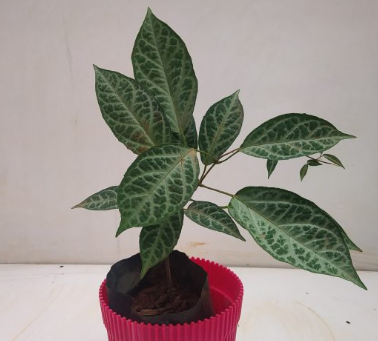Bignonia Argyro Plant
Bignonia Argyro is a moderate-growing climber reaching 10–20 ft, thriving in USDA zones 9–11, with well-drained loamy soil, full sun to partial shade, and moderate moisture, with no edible or medicinal uses.

Habit
Climber
Height
3-6 m
Growth
Moderate
Soil
Well-drained, loamy soil
Shade
Full sun to partial shade
Moisture
Moderate moisture
Edible
No
Medicinal
No
Origin
Tropical America
Climatic Condition
Tropical to Subtropical
Temperature (°)
20-30°C
Humidity (%)
60-80%
Potting media
Peat-based mix
Fertilizers
Organic compost
Watering
Water regularly; avoid overwatering
Plant Weight
0.5-1 kg
Flowering Time
Summer to Fall
Soil Ph level
6.0 - 6.5
Water Ph level
5.5 - 6.5
Soil EC
0.4 - 0.6
Yield Per Plant
Ornamental use
NPK ratio
10:10:10
life Span
Perennial
Health Benefits
Ornamental flowers; attracts pollinators.
Suggested Grow Media or Potting Mix ?
50% loamy soil, 30% compost, 20% sand
Suggested Fertigation/Fertilizers
Fertilize monthly with phosphorus-rich fertilizer.
Common Diseases and Remedies
Powdery Mildew, Leaf Spot, Root Rot, Spider Mites, Scale
White coating on leaves, brown spots, wilting, webbing
Copper fungicides, miticides
HEALTH BENEFITS
Possible Health Benefits of Bignonia Species
Plants in the Bignoniaceae family have been traditionally used for various medicinal purposes, including:
- Anti-Inflammatory Properties – Some species contain compounds that may help reduce swelling and pain.
- Antioxidant Benefits – Rich in flavonoids and phenolic compounds that protect against oxidative stress.
- Respiratory Health Support – Certain species are used in traditional medicine for treating coughs, asthma, and bronchitis.
- Antimicrobial Properties – Some species have antibacterial and antifungal effects, helping with infections and wound healing.
- Digestive Aid – Some species are used in herbal medicine to support digestion and relieve stomach discomfort.

